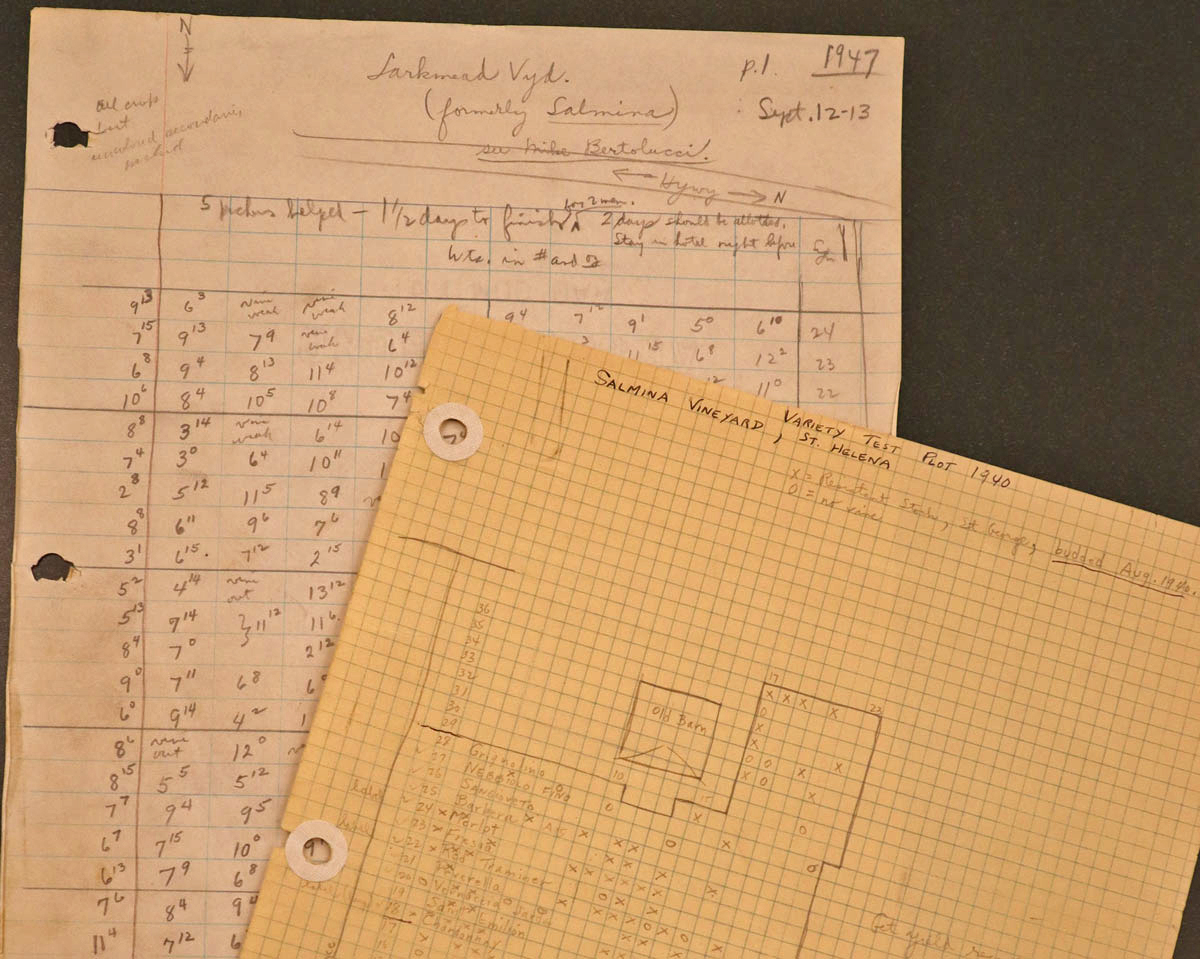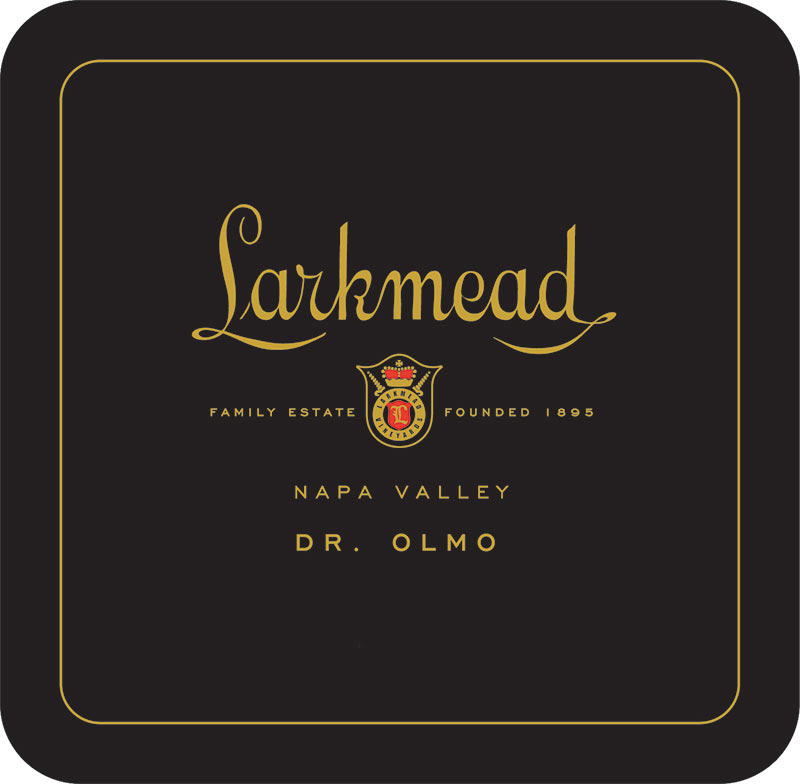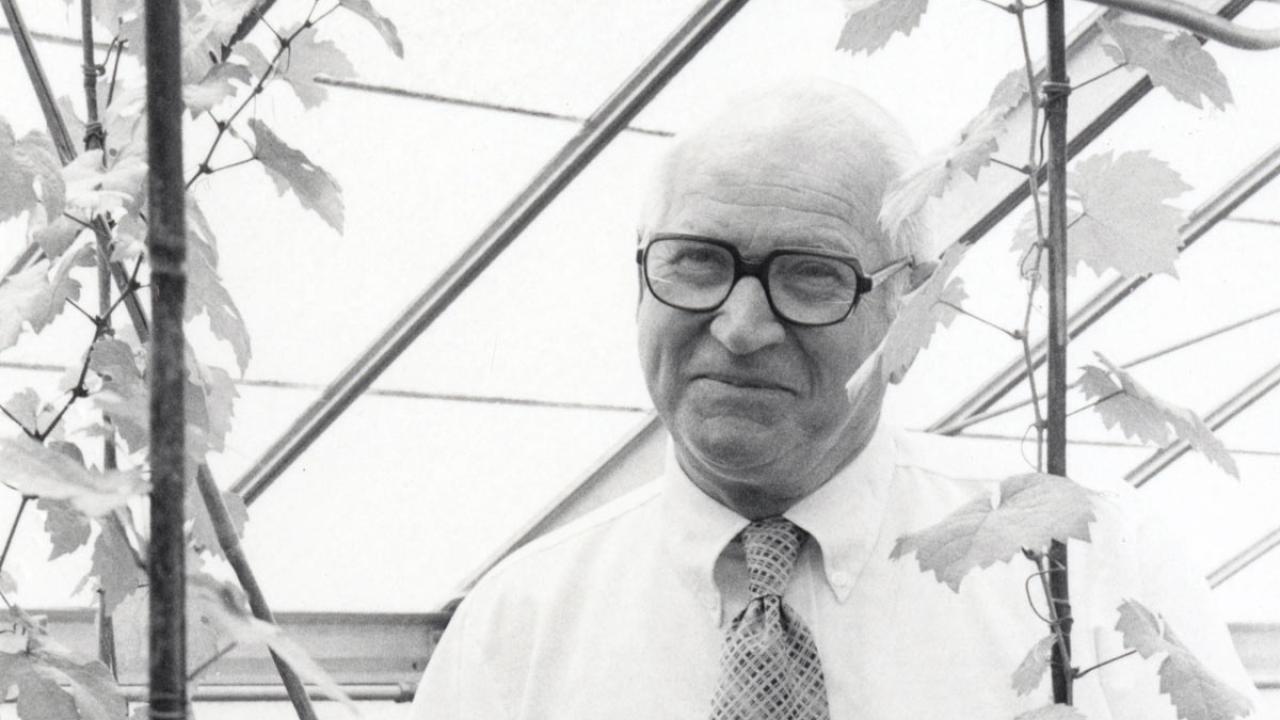Quick Summary
- Larkmead Vineyards owners give $200,000 to the UC Davis Library to further preserve and broadly share the Harold Paul Olmo Papers
- Professor Olmo played an integral role in establishing UC Davis’ international reputation in wine
- His development of a famed cabernet sauvignon grape variety started with a clonal station he planted at Larkmead 80 years ago
Forever bound by the fruits of decades-old viticultural research, the late Professor Harold Olmo and a Napa Valley vineyard have a new lasting connection — at the UC Davis Library.
With a recent gift of $200,000 from Cameron “Cam” Baker and Kate Solari Baker, owners of Larkmead Vineyards, the library will further preserve and share the Harold Paul Olmo Papers — by digitizing them, thus allowing broader access to his work in grape breeding and the suitability of grape varieties to different climates and terrains around the world.
“As we preserve and increase access to these documents, we hope to uncover elements of Olmo’s research that could provide new insight into modern-day viticulture practices,” said MacKenzie Smith, university librarian and vice provost of Digital Scholarship. “This project is a powerful example of how, through digital scholarship, we can connect the past with the present to better inform the future.”
The ‘Oakville selection’
In 1939, a year after he joined the UC Davis faculty, Olmo planted a clonal station at Larkmead, launching a wine grape breeding project that would lead to one of his greatest achievements. He took his Larkmead clones to the university’s Oakville Station for trials, and eventually developed cabernet sauvignon FPS 02, commonly known as the “Oakville selection” — considered fundamental in establishing cabernet sauvignon as California’s signature grape variety.
He released more than 30 wine and table grape varieties in his 40-year career, and his clones are still widely planted today. Cabernet sauvignon remains the star of the Napa Valley, and chardonnay — with his research into improved fruit quality and productivity — became California’s most widely planted grape variety.

“Dr. Olmo was one of the most influential viticulturists of the 20th century,” Cam Baker said. “Napa Valley owes much of its success as a wine region to him. It’s our hope that through the digitization and analysis of Dr. Olmo’s research by the UC Davis Library, more findings will come to light that will guide Napa Valley into its next chapter.”
For example, Olmo researched the impacts of climate change on viticulture practices more than 60 years ago in the Swan Valley of Western Australia, and his work there transformed Australian winemaking for generations. This research could yield clues to how California grape growers and winemakers might adjust their practices to better adapt to climate change.
Clones in the vineyard
Larkmead changed hands in 1948, and the new owner, Larry Solari, and Olmo became fast friends. Olmo shared critical advice on rootstocks and clonal research, in addition to infusing a culture of experimentation.
“In the short term, Dr. Olmo’s incredible knowledge and experience certainly helped contribute to our family’s early success as a grape grower,” said Solari Baker, Solari’s daughter.

“The fact that Dr. Olmo chose to develop his clonal station at Larkmead also helped build the vineyard’s reputation for top quality terroir in Napa Valley.
“But the true effects of Dr. Olmo’s research are long term. Today, we actually have Dr. Olmo’s groundbreaking Oakville clones planted in the vineyard, meaning that our cabernet sauvignon wines are in part a direct result of his work and legacy.”
Larkmead Vineyards is already taking a page from Olmo’s notebook, having announced the planting of a three-acre research block that will host different varieties, clones and rootstocks for experimentation as climate change affects Napa Valley.
‘Ideal fit for this gift’

In 2015, to honor the late professor and his influence on the vineyard, Larkmead introduced its Dr. Olmo-label cabernet sauvignon, made with grapes from the parcel where he grew the vines that led to the “Oakville selection.”
In providing funds for digitizing his work, the vineyard is also celebrating its 125th anniversary this year. “By reflecting on our past and learning all we can from it, we will be better prepared for our next 125 years here in Napa Valley,” Kate Solari Baker said.
The gift acknowledges what she described as UC Davis’ “unparalleled reputation in the wine industry, with the leading viticulture and enology program and the best wine library in the world.”
“Given the university’s importance for the global wine industry and its strong ties to the Napa Valley, we felt very confident that UC Davis was the ideal fit for this project and gift,” she said.
The library will digitize the Harold Paul Olmo Papers over the next year. To request access to materials from the collection, contact Archives and Special Collections by email.
Read Sarah Colwell’s article in its entirety on the UC Davis Library website.
Media Resources
Sarah Colwell, 530-752-9842, sccolwell@ucdavis.edu
